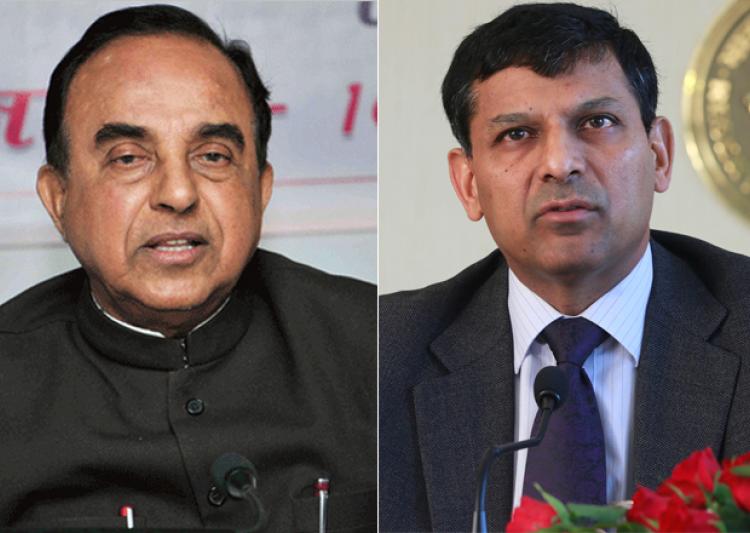Arnav Deshpande on the fallacies in arguments levelled against Gov. Rajan by Dr. Swamy.
 The repeated assaults launched by Dr. Subramanian Swamy are characterised by what the right can do best- character assassination. By questioning RBI Governor Dr. Raghuram Rajan’s integrity with frivolous accusations (he renewed his green card and hence is half-nationalistic), the larger dynamic of jingoism is revealed. By turning ourselves into hermits, and seeking conformity from all and sundry for the isolationist and chauvinist definitions of nationalism, we shall rid ourselves of all that is good. This is only the tip of the dangerous iceberg that hyper-nationalism can be, and if our ship doesn’t steer clear in the next three years, the psyche of the nationalist will refuse any wisdom, any introspection or rationality. Keeping away from that dirty polemic, let me concentrate merely on few arguments raised by Dr. Swamy, which target the policy than the person.
The repeated assaults launched by Dr. Subramanian Swamy are characterised by what the right can do best- character assassination. By questioning RBI Governor Dr. Raghuram Rajan’s integrity with frivolous accusations (he renewed his green card and hence is half-nationalistic), the larger dynamic of jingoism is revealed. By turning ourselves into hermits, and seeking conformity from all and sundry for the isolationist and chauvinist definitions of nationalism, we shall rid ourselves of all that is good. This is only the tip of the dangerous iceberg that hyper-nationalism can be, and if our ship doesn’t steer clear in the next three years, the psyche of the nationalist will refuse any wisdom, any introspection or rationality. Keeping away from that dirty polemic, let me concentrate merely on few arguments raised by Dr. Swamy, which target the policy than the person.
Dr. Swamy suggests that by raising interest rates, Dr. Rajan brought recession to small and medium industries. Dr. Swamy is correct in guessing the result, which indeed is an implicit recognition of the failings of the Modi administration on the economic front, but wrong in diagnosing the cause. Raghuram Rajan took over from Duvuri Subbarrao in a period of a double-digit inflation, ballooning current account deficit and low growth. With the monetary contraction, inflation calculated by the Wholesale Price Index (WPI) did indeed take a plunge into negative territory, while the inflation calculated by the Consumer’s Price Index hovered above 6%. This divergence has nothing to do with the policy of contraction and everything to do with the circumstances. WPI and CPI baskets are compositionally divergent and differ also with regard to allocation of weights.
One observes that petroleum products enjoy greater weight in WPI and lower weight in CPI. With oil prices plunging below $50 per barrel their deflationary impact was felt much more pronouncedly in WPI than in CPI. Similarly, food products enjoy higher weight in CPI than WPI and the agrarian shortage which pushed up food price inflation put upward pressure on CPI. Compositional differences meant that the fall in global commodity prices from metals and minerals to oil and raw materials for production put downward pressure on WPI, not affecting the CPI basket as significantly.
So should Rajan’s policy have rather focussed on promoting WPI inflation than controlling CPI inflation?
No, for few reasons.
Firstly, India is an emerging economy characterised by supply constraint. The economy, hence, shows greater inflationary tendency. By loosening policy rates to bringing the industry sector to grow, excess money supply would not have stopped the general rise in prices of CPI commodities. CPI commodities moreover, constitute the largest chunk of the consumption basket of most households in an emerging economy like ours. The rising nominal cost of real expenditure required on CPI commodities would boomerang by reducing saving, as people spend more to maintain real consumption, lowering investment and hurting the economy’s health in the medium to long run.
Secondly, Dr.Swamy rests his argument on a vague premise – his economic theory assumes that monetary contraction is a necessary and sufficient condition for boosting growth in general and growth among small and medium enterprises in particular. This argument is essentially flawed as the interest rate regime is not the sole determinant of growth, but one among multiple factors influencing it. Other factors include the current level of infrastructure, the state of education, the nature of healthcare, the ease of doing business, the political atmosphere, the macro-economic atmosphere, the prevailing debt scenario and the capability of banks to lend. Ignoring so many such factors and narrowing discussion on growth merely to the monetary aspect of tight interest rate smacks of an unseen trust in the self-correcting, all-pervasive and self-sufficient market mechanism that even Chicago-schoolers are likely to find rather dubious. It hence is too irresponsible to assume that the loose rate shall inspire the market through self-correction, thus producing the big bang growth that Dr.Swamy wants to see.
Also, Dr. Swamy hasn’t considered that the rate of job growth or growth in the general sense derives from the nature of the economy. A service-oriented growth effort in the absence of adequate investment in education and healthcare does not drive an adequate number of people from the farms to the offices; nor does the heavy capital investment approach do much towards that direction in a labour-surplus economy. PM Modi, erstwhile CM of Gujarat, did both, crushing MSMEs, an error in part responsible for the Patel unrest, and in whole responsible for the poor human indicators in the state. Looking at the larger picture, the question to ask, then, becomes not ‘Why doesn’t big growth happen?’ but, ‘How do we make moderate growth optimally inclusive?’Obsession with big numbers often leads this aspect to be lost, and it is this question that brings me to my next argument.
Inflation in an atmosphere of economic inequality exacts different costs from different classes. Price rise is a non-discriminatory phenomenon in the open market, whereas the marginal utility of every additional unit of currency lost is larger to a poor citizen than to the affluent citizen (the poor man must use his 1000 rupees for the satisfaction of multiple desires, while the rich man might as well save). Thus maintaining the real value of consumption becomes an uphill task for the man of meagre resources, and leaves her worse off relative to her affluent counterpart.Thus a general rise in prices shows the characteristic of distributional inequality. Moreover, the general rise shall exact a greater cost from the poor when it occurs among goods that citizens consume daily-food, fuel, apparel etc, which are gauged by the CPI basket.
The true ailments plaguing the medium and small enterprises range from the shortfall in infrastructure facilities and inadequate policy support for such enterprises. They are also reflected in the long-standing services biased growth model in our country. The immediate reasons for the slowdown range from weak rural demand to cold exports. The absence of robust credit offtake derives as much from the fact that with ballooning stressed assets, banks are not in a position to lend, which is shown by the inertial transmission of rate cuts to consumers in the economy.
Dr.Swamy fails to understand that robust growth derives from not one but multiple factors that must act as complements. He shows a remarkable elitism when he suggests by implication, promoting WPI inflation while ignoring CPI inflation. His elitism is also rather biased, as a majority India’s MSMEs face a shortfall of availability of and access to credit in the first place, while the interest rate regime comes later. He ignores the welfare of a majority of consumers in favour of a minority of producers. He projects supply-side thinking, without accounting for the losses on the demand-side that would occur through erosion of real purchasing power due to a resurgent CPI inflation. His supply-side thinking is also myopic, as the previously explained fall in saving and investment would ultimately hit production in the medium to long run.
Swaminomics thus seems to be an exercise in preparation of a new RBI Governor. Any guesses?
Disclaimer: The opinions expressed within this article are the personal opinions of the author. Spectralhues is not responsible for the accuracy, completeness, suitability, or validity of any information on this article. The information, facts or opinions expressed in the article do not reflect the views of Spectralhues and Spectralhues does not take any responsibility or liability for the same.








